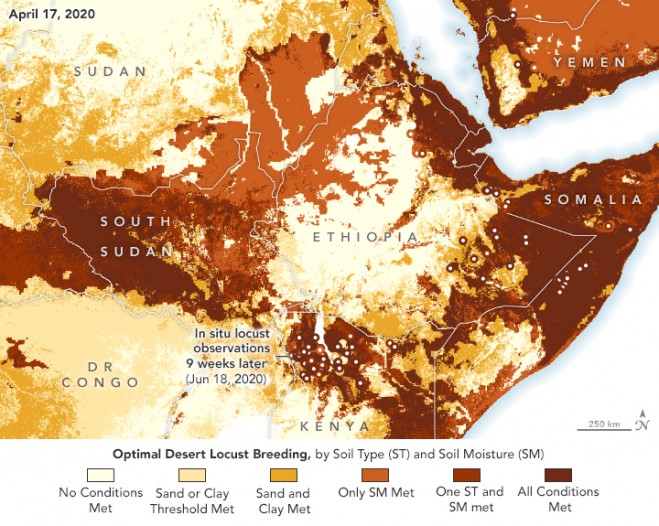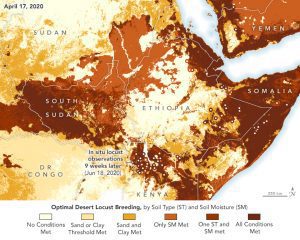

A map shows soil conditions on April 17, 2020, overlaid from locust observations from June 18, 2020, when infestations increased in Kenya. (Credit: NASA Earth Observatory images by Lauren Dauphin, using data from Ellenburg, W. Lee, et al. (2021))
In 2019-2020, eastern Africa experienced its worst desert locust invasion in more than 40 years. The United Nations and its partners treated more than 17,000 square kilometers (6,600 square miles) of locust infestations across 10 countries with various eradication methods. Countless crops were still devoured by the insects, causing serious food insecurity in the region.
As the outbreaks grew and migrated, NASA-funded researchers worked to better forecast when and where the swarms would appear. In a recently published study, the team showed that by examining soil moisture and soil composition, they could predict optimal breeding sites 85 percent of the time.
“We looked at soil moisture and texture because those are critical components to the locust life cycle,” said Lee Ellenburg, the food security and agriculture lead for NASA’s SERVIR program and the study’s lead author. “We are essentially identifying where the locusts are breeding.”
The most effective time to eradicate desert locusts (Schistocerca gregaria) are when the insects are in the egg and hopper phases, a period when they are still developing wings and have limited mobility. Females tend to lay eggs in warm, wet and sandy-clay soils at a depth of 10 to 15 centimeters (4 to 6 inches) below the surface.
In roughly two to four months, the locusts mature and develop wings, at which point it becomes difficult to find and eradicate them. Adults can fly more than 150 kilometers (90 miles) per day; swarms can even cross the Red Sea, as they did in 2019-2020. Just one square kilometer of a locust swarm can contain as many as 80 million adult locusts.
There are no upcoming events.
